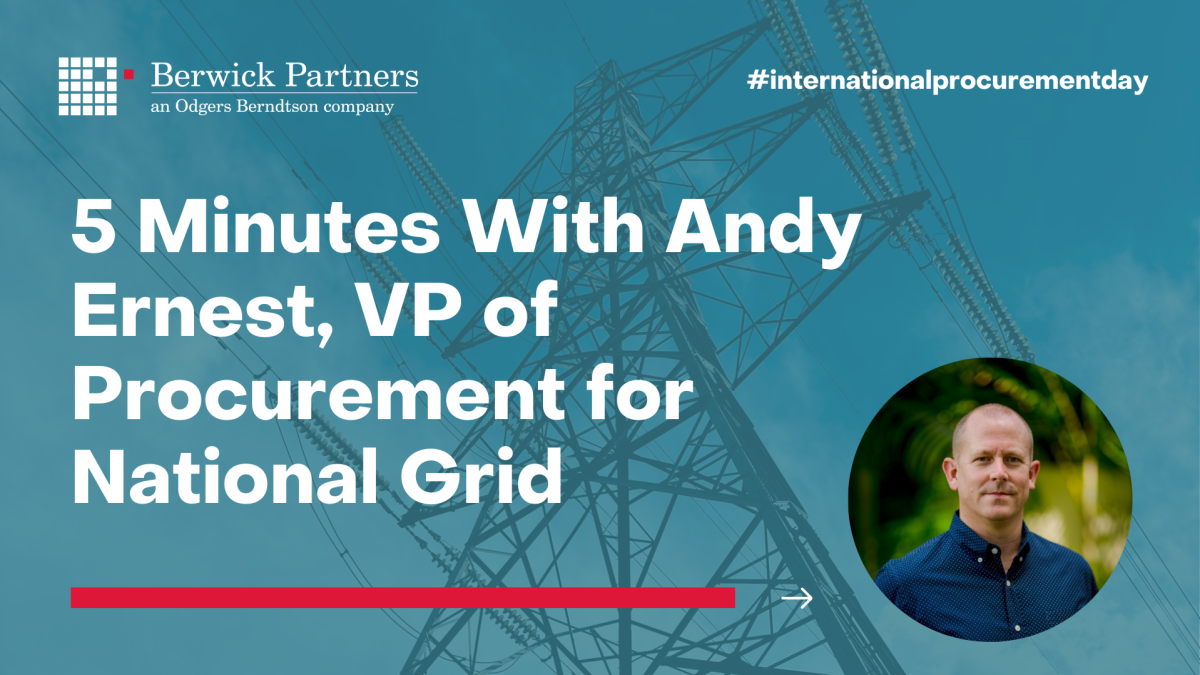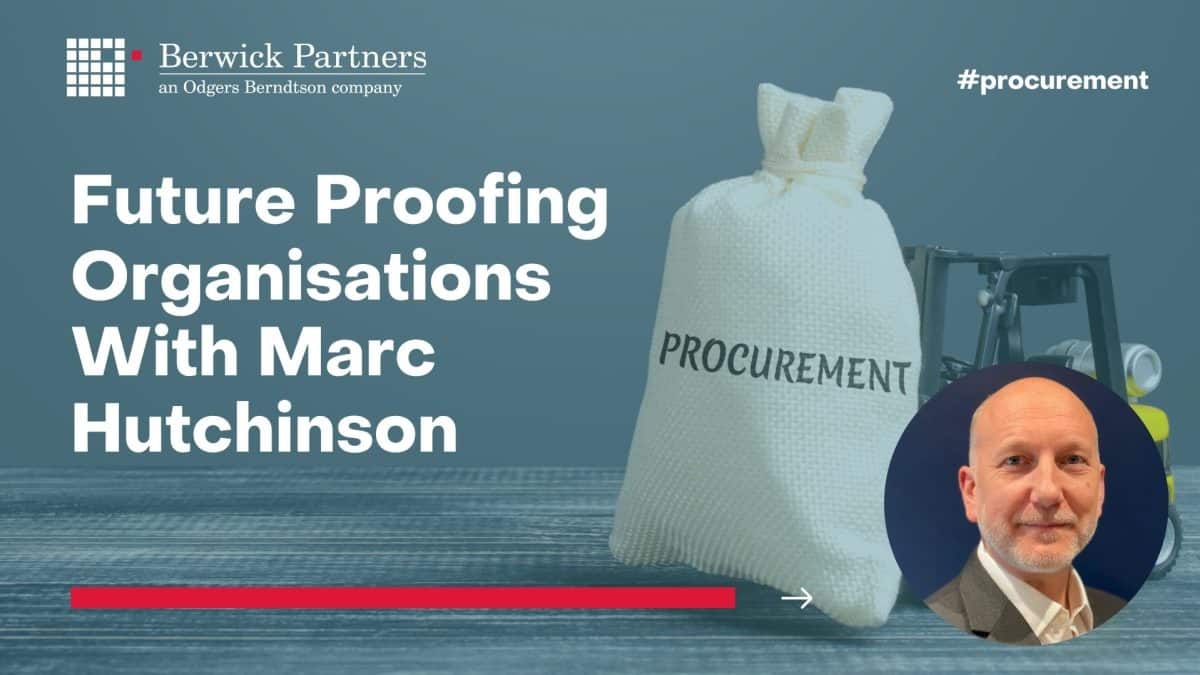Five minutes with…Dr Jo Meehan, Senior Lecturer, Operations and Supply Chain Management, University of Liverpool
Jo Meehan is a leading academic and noted thought leader in the procurement discipline. Her work focuses on power and the social-economic impacts of procurement. Jo’s research is recognised internationally and impacts policy and professional practices in UK organisations across public, private and third sectors. In our latest edition of our ‘Five minutes with…’ series, Berwick Partners’ Richard Guest spoke with Jo about the impact of COVID-19 within the procurement function and what we can learn from it.
By focusing all our attention on the effects of COVID-19 are we walking blindly into another pandemic?
I’m currently part of an international research team undertaking a piece of work assessing the impact of COVID-19 across firms in the UK, Finland, and Germany, specifically looking at what procurement functions were, and weren’t, paying attention to pre-COVID, and whether this correlates to their commercial responses. The results are being analysed and the insights will be shared in the autumn. In most instances the function has risen to the challenge of the pandemic; we’ve witnessed some amazing work through agile approaches and cutting through procedures that often stifle change and innovation. The pandemic should be a wake up for the function to really focus on where the new risks, and opportunities, may emerge from. COVID-19 has clearly highlighted that our supply chains and economic system are intertwined with health, the environment, political, education, transport and infrastructure systems. Procurement leaders need to raise their gaze beyond managing contractual risks to understand wider interdependencies and how we account for and interact with these. COVID-19 has forced our attention onto certain things that are very particular to COVID-19, but what about the other risks as a result of another pandemic and what are we missing? Are there any patterns that we can learn from?
Many organisations externalise risk, particularly around issues which are related to the environment or society. They are generally only seen as something to be mitigated and managed – but the risks will always be there with this approach. COVID-19 has forced some firms to account for external factors more closely in their internal decision making, and in some cases has enabled innovative ways to think completely differently. But we won’t achieve a paradigm shift if we only view risk as something to be managed.
COVID-19 has exposed a huge area of risk for the procurement function – data. We are all, as consumers and firms, guilty of giving data and privacy away to IT and hosting companies, but we’re just not yet attuned to the risks from doing this. We see tech suppliers and their solutions helping us work in this new environment, whilst giving away so much of our real intelligence. It’s hugely problematic that we don’t realise the value that’s within our data, and the sheer commercial, political, and social power it gifts suppliers, particularly the very dominant ones in highly concentrated markets.
Power
Historically, commercial power was associated with major oil companies as their prices controlled the global rates of production and economic growth. As consumerism grew, power shifted towards retail giants who used marketing and data to influence what we wanted to buy, but now power is more insidious. It’s the dominant IT, social media, and infrastructure companies who own our data and they can use analytics to shape not necessarily what we want to buy, but what we think. I don’t get a sense that procurement is giving this sufficient attention in commercial contracts. We are not protecting our IP and data sufficiently, if at all in some quarters, and markets are becoming ever more concentrated, putting more and more power in the hands of a few firms.
Make no mistake, there are huge benefits that procurement can gain with big data and analytics, but I’m concerned that we aren’t fully understanding or debating the many complex risks associated with it.
Agility
In recent months, we have all seen the way that many organisations have demonstrated agility in shifting their service delivery modes or adapting product ranges in response to the lockdowns. Many that have prospered have had diverse supply bases and business models, and strong supplier relationships. Those in heavily specialised supply chains in comparison have struggled to adapt.
Procurement needs to be commercially prominent in the firm to contribute to opportunities around repurposing materials and services. The firms who really understand their supply chains and where their supply chains originate, have fared much better. The firms who don’t manage beyond tier one have struggled the most, as they haven’t realised how exposed they might be as they don’t fully understand the shape and subsequent risk in their supply chain.
Are we going to see an increase in near-shoring activity?
I think there is an intention to – whether we can or not is the critical question. There are issues around capacity and local skills to do this effectively, as we are so reliant on global companies and we might be looking at this through a very restricted COVID-19 lens. What happens if the next shock affects national suppliers and we become reliant on a more global supply chain? This all comes down to stress-testing current supply chains and how we map choice. The more options we have in our supply chain the more agile we can become. Where we have dependencies there is always a risk, but with that generally comes a cost – we have dependencies in our supply chains because it’s cheaper. If we go outside our normal contracts, or split our sourcing decisions, we’re likely to see costs rise and the vast majority of these costs are unsustainable in the long term. At the heart of the issue here is the dominance of cost leadership strategies and the very low margins across so many industries. As firms have tolerated squeezed margins for so long, single digit margins have been legitimised. While this might be sustainable for mass markets, it is highly problematic where production is not sufficiently scaled and for service industries. We have become accustomed as buyers to low prices, but they are often built on inequitable value distribution, labour exploitation, vulnerable work, or environmental damage. But unless we truly understand the conditions across our whole supply chain, we can be blind to these consequences.
There is a big challenge for procurement and organisations coming out of this if we all want a fairer world. If firms want to be less reliant on suppliers and have opportunities to be more agile to changes, then there may be a cost to that. But, if we really want to address the systemic inequalities and vulnerabilities in our supply chains, we need to reset what we buy, how we buy, and who we buy from. Leadership is needed here as there are so many commercial pressures to recover lost profits and there is a real danger that we bake in unsustainable and unethical practices. If ever there was a time to rethink our wider moral obligations as procurement leaders, surely it is now? But these decisions rest on an assumption of transparency, choice, and willing customers. If we don’t have these, our job might be about how to get them.
Is there an opportunity for procurement to shape markets?
This is where we need to start working much more; how are we collectively shaping market conditions? I recently undertook a piece of works for CIPS with Professor Louise Knight looking at ’futures’. One of procurement’s blind spots we identified was that firms look at what they do in their own supply chains and what they don’t look at is the aggregate consequences of buying behaviour. Buyers need to broaden their view to notice trends and signals in the market. Buyers don’t just buy under certain market conditions; buyers create the conditions. The procurement professionals we spoke to often lamented the lack of supply diversity but failed to question the consequences of buying from dominant firms and not engaging with start-ups or SMEs.
What will the procurement function of the future look like?
Much of the function could be redundant due to the impact of AI as a lot of the activity is likely to be automated through sourcing and contract management algorithms – but they will be ‘blind’ to more consequential dimensions unless we build them in to the systems in the first place. If we only look to our past data to develop algorithms, we risk hardwiring in our unseen biases, prejudices, and unsustainable practices. Procurement is likely to move to a more analytical role, not just crunching numbers, but understanding the impact of commercial decisions in their widest sense. So, while many of the processes might become automated, it is the combination of machine learning and human curation that is most likely outcome.
Counter intuitively, with the growth of automation, the relational side of our role is even more critical. We need to build relationships and social capital with suppliers to truly be able to manage supply chains. We need to understand suppliers’ motivations and whether these are the type of organisations we want to partner with. We also need to build internal relationships and recognise there is rarely an optimal decision from a binary set of choices – there are always trade-offs. The intelligence and skillset required by procurement leaders is not about getting the right answer, it is about asking the right questions.
Do you think organisations will default back to pre-COVID ways of working?
I fear many already are, which highlights how narrowly we value success in business. It’s current definition, is only measured in very economic terms – profits, margins, and ultimately growth. There are other metrics that we can add to our governance and strategic decisions and we need to leverage the lessons from COVID-19 so firms are able to make ‘better’, fairer and more sustainable decisions, and crucially, be held accountable for them.
What opportunities do you see for procurement coming out of this?
There is a huge opportunity around how, and why, we might engage with our supply base. Procurement has illustrated in recent months how we can be creative problem solvers, particularly working in partnerships with our suppliers, and we’ve witnessed genuine innovation in terms of materials, service delivery, and re-purposing. Working in this mode can be exhausting and there is a need for parts of our supply chains to now rebuild stability. But procurement needs to be open to more of this type of innovative working to solve some of the more complex issues. The climate emergency, modern slavery, resource depletion, protectionism, social inequalities and systemic prejudice are all intertwined with our economic systems. These are not issues that firms can solve in isolation, and COVID-19 has put a spotlight on the dependencies and vulnerabilities within and across our supply chains. Procurement leaders need to consider how to truly understand the totality of our supply chain operations to consider how to create the conditions to keep inspiring our suppliers to help create more diverse and sustainable supply chains.
For more information, please contact Richard Guest is a Principal Consultant in our Procurement and Supply Chain practice.






